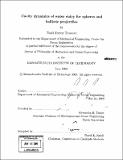| dc.contributor.advisor | Alexandra H. Techet. | en_US |
| dc.contributor.author | Truscott, Tadd Trevor | en_US |
| dc.contributor.other | Massachusetts Institute of Technology. Dept. of Mechanical Engineering. | en_US |
| dc.date.accessioned | 2010-01-07T20:56:40Z | |
| dc.date.available | 2010-01-07T20:56:40Z | |
| dc.date.copyright | 2009 | en_US |
| dc.date.issued | 2009 | en_US |
| dc.identifier.uri | http://hdl.handle.net/1721.1/50584 | |
| dc.description | Thesis (Ph. D.)--Massachusetts Institute of Technology, Dept. of Mechanical Engineering, 2009. | en_US |
| dc.description | Includes bibliographical references. | en_US |
| dc.description.abstract | The free surface impact of solid objects has been investigated for well over a century. This canonical problem has many facets that may be studied: object geometry, surface treatment, and diameter; impact speed and angle; and fluid viscosity and surface tension. The problem is further enriched with the consideration of varying mass ratios and rotational velocities. This thesis uses advanced high-speed imaging and visualization techniques to discover underlying physics and further our understanding of these phenomena through improvements to analytical solutions describing criterion such as cavity formation, depth of deep seal, and trajectory for all impact parameters studied. The topic is extended to the impact of high-speed projectiles or bullets. Through experimentation the trajectory, cavity size, and forces acting on the projectiles are elucidated. Experimentation coupled with improvements to an existing cavitation model lead to an improved bullet design that forms a narrower cavity and achieves higher speeds. Industrial applications include ship slamming, extreme waves and weather on oil platforms, sprayed adhesives, paint aerosols and ink jet printing. In the field of naval hydrodynamics there is particular interest as these problems relate to the study of the water entry of mines and bullets, and the underwater launching of torpedos and missiles. Physical insight can also be applied to sports performance research relating to the water entry of athletes, reducing drag of swimmers near the free surface, decreasing cavity formation for divers, and the entry and exit of oars in rowing. | en_US |
| dc.description.abstract | (cont.) This thesis examines the effect of several key parameters on the water entry physics of spheres at relatively low Froude numbers including: hydrophobic vs. hydrophilic surfaces, mass ratio and rotational velocity. Physical models that predict the depth of deep seal and the effect of dynamic and static wetting angle on cavity formation will be discussed. Theories are derived from physical parameters witnessed through high-speed video image sequences using advanced image processing techniques. New phenomena have been witnessed via these techniques including a wedge of fluid that crosses the cavity in the case of transverse rotational velocity. Furthermore, the images reveal the forces acting on the sphere through the entire trajectory, which adds valuable information for future theoretical models. The discussion continues with the water entry of bullets, which produce water vapor cavities large enough to engulf the projectile (i.e. supercavitation). The effects of speed, geometry and angle of attack on the formation of the subsurface cavity are analyzed through an improved physical model and full scale experimentation. The analytical model is then used to improve the design of projectile geometry to allow for more efficient travel inside the cavity and experimentally validated. | en_US |
| dc.description.statementofresponsibility | by Tadd Trevor Truscott. | en_US |
| dc.format.extent | 306 p. | en_US |
| dc.language.iso | eng | en_US |
| dc.publisher | Massachusetts Institute of Technology | en_US |
| dc.rights | M.I.T. theses are protected by
copyright. They may be viewed from this source for any purpose, but
reproduction or distribution in any format is prohibited without written
permission. See provided URL for inquiries about permission. | en_US |
| dc.rights.uri | http://dspace.mit.edu/handle/1721.1/7582 | en_US |
| dc.subject | Mechanical Engineering. | en_US |
| dc.title | Cavity dynamics of water entry for spheres and ballistic projectiles | en_US |
| dc.type | Thesis | en_US |
| dc.description.degree | Ph.D. | en_US |
| dc.contributor.department | Massachusetts Institute of Technology. Department of Mechanical Engineering | |
| dc.identifier.oclc | 464284708 | en_US |
